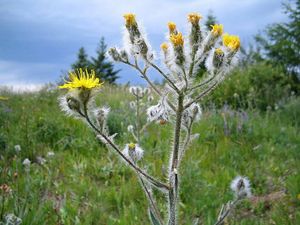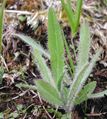Hieracium scouleri
- Scientific Name: Hieracium scouleri
- Family: Asteraceae
- Common Names: hound tongue hawkweed, Scouler's hawkweed, woolly weed
- Synonyms/Misapplications: Hieracium albertinum, Hieracium chapacanum, Hieracium cusickii, Hieracium cynoglossoides
- Codon: HIESCO
Contents
Taxonomy
| Scientific classification | |
|---|---|
| Kingdom: | Plantae |
| Subkingdom: | Viridiplantae |
| Phylum: | Tracheophyta |
| Subphylum: | Spermatophytina |
| Class: | Magnoliopsida |
| Subclass: | Asteranae |
| Order: | Asterales |
| Family: | Asteraceae |
| Genus: | Hieracium L. |
| Species: | Hieracium scouleri Hook. |
| Synonyms | |
| |
Description
Native rhizomatous perennial, stem ranging from nearly glabrous to densely wooly-hairy, stem producing a milky juice.[2][3]
Leaves are elliptical, winged petioles towards base, becoming smaller and sessile up the stem.[4] Leaves are generally hairy on both sides, with long, smooth, or barbellate hairs, not glandular, if leaves are subglabular (almost hairless), then the midveins and margins often have short-glandular hairs, leaves tufted at base during anthesis.[3]
Inflorescence consists of yellow ray florets, subtended by an involucre of overlapping gland tipped bracts.[5] Receptacle naked.[3]
Fruit is a ribbed achene, ~3mm. long, pappus whitish or tawny.[6]
Genus comes from Greek hierax, hawk.[3]
Bloom Period
June-August.[4]
Distribution
Central BC to northern California, east to Alberta, Montana and Utah.[3]
Habitat
Forest, meadows, prairies, rocky slopes, stream banks, roadsides, thickets.[3]
Uses
Sx̌ʷyʔiɬpx use of infusion of leaves and roots, taken as a general tonic.[7]
Propagation
See White, Chris, 'Plant Propagation Protocol for Hieracium scouleri' Available at http://courses.washington.edu/esrm412/protocols/protocols_files/forbs_III.htm for propagation information.
Photo Gallery
References
- ↑ Integrated Taxonomic Information System. Retrieved from https://www.itis.gov/servlet/SingleRpt/SingleRpt?search_topic=TSN&search_value=37728
- ↑ David J. Keil 2012, Hieracium scouleri, in Jepson Flora Project (eds.) Jepson eFlora, /eflora/eflora_display.php?tid=3542, accessed on June 10, 2020.
- ↑ 3.0 3.1 3.2 3.3 3.4 3.5 Hitchcock, C. L., Cronquist, A., Giblin, D., & Legler, B. et al. (2018). Flora of the Pacific Northwest: an illustrated manual. Seattle: University of Washington Press.
- ↑ 4.0 4.1 WTU Herbarium, Burke Museum, & University of Washington. Retrieved from https://biology.burke.washington.edu/herbarium/imagecollection/taxon.php?Taxon=Hieracium%20scouleri
- ↑ Bowcutt, F., & Hamman, Sarah. (2016). Vascular plants of the South Sound prairies (First ed.). Olympia, Washington: The Evergreen State College Press.
- ↑ Klinkenberg, Brian. (Editor) 2020. E-Flora BC: Electronic Atlas of the Plants of British Columbia [eflora.bc.ca]. Lab for Advanced Spatial Analysis, Department of Geography, University of British Columbia, Vancouver. [Accessed:2020-06-10 1:03:07 PM]
- ↑ Turner, Nancy J., R. Bouchard and Dorothy I.D. Kennedy, 1980, Ethnobotany of the Okanagan-Colville Indians of British Columbia and Washington, Victoria. British Columbia Provincial Museum, page 84. Retrieved from http://naeb.brit.org/uses/search/?string=hieracium+scouleri





